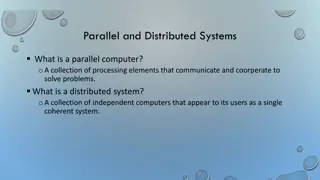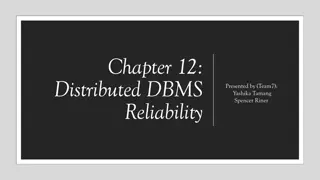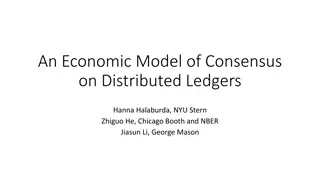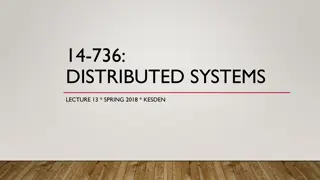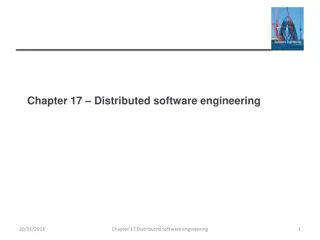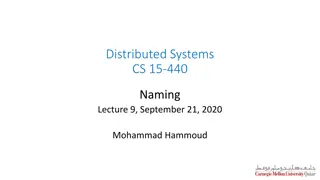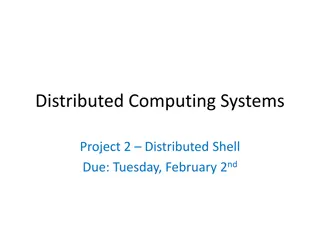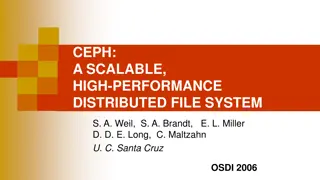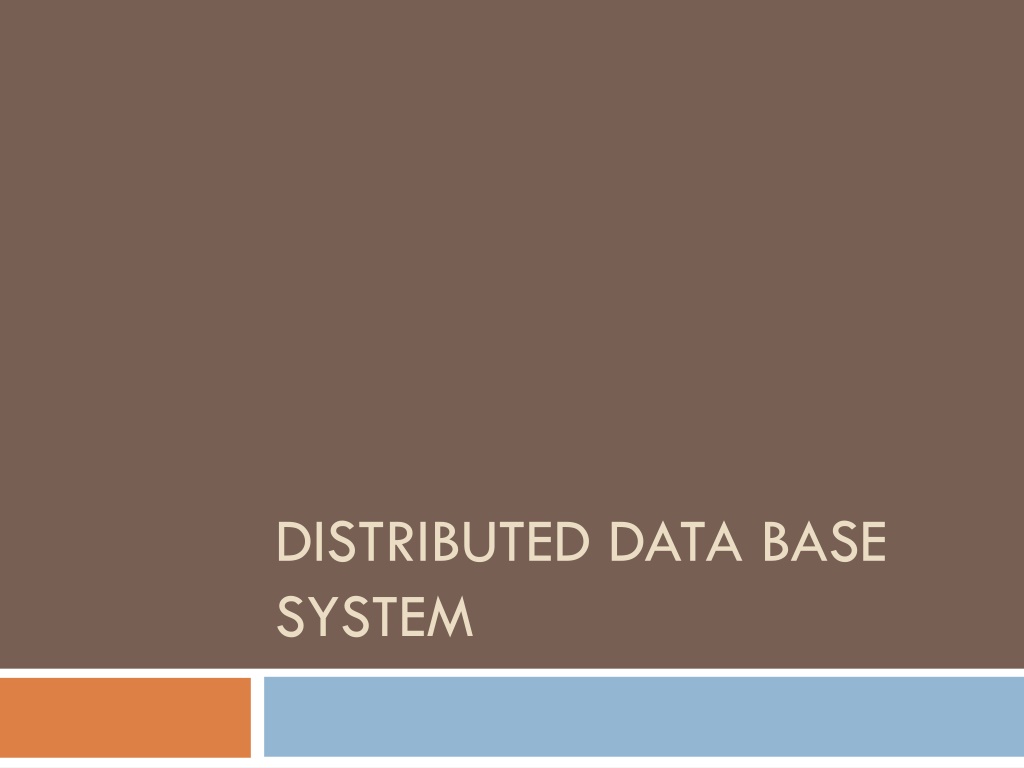
Understanding Distributed Database Systems
Distributed database systems involve storing data across multiple sites to allow global access. Learn about homogeneous and heterogeneous databases, data storage methods, and the challenges of maintaining consistency in distributed data.
Download Presentation

Please find below an Image/Link to download the presentation.
The content on the website is provided AS IS for your information and personal use only. It may not be sold, licensed, or shared on other websites without obtaining consent from the author. If you encounter any issues during the download, it is possible that the publisher has removed the file from their server.
You are allowed to download the files provided on this website for personal or commercial use, subject to the condition that they are used lawfully. All files are the property of their respective owners.
The content on the website is provided AS IS for your information and personal use only. It may not be sold, licensed, or shared on other websites without obtaining consent from the author.
E N D
Presentation Transcript
DISTRIBUTED DATA BASE SYSTEM
What is DDBMS? A distributed database is basically a database that is not limited to one system, it is spread over different sites, i.e, on multiple computers or over a network of computers. A distributed database system is located on various sited that don t share physical components. This maybe required when a particular database needs to be accessed by various users globally. It needs to be managed such that for the users it looks like one single database.
Types: 1. Homogeneous Database: In a homogeneous database, all different sites store database identically. The operating system, database management system and the data structures used all are same at all sites. Hence, they re easy to manage.
2. Heterogeneous Database: In a heterogeneous distributed database, different sites can use different schema and software that can lead to problems in query processing and transactions. Also, a particular site might be completely unaware of the other sites. Different computers may use a different operating system, different database application. They may even use different data models for the database. Hence, translations are required for different sites to communicate.
Distributed Data Storage There are 2 ways in which data can be stored on different sites. These are: 1. Replication In this approach, the entire relation is stored redundantly at 2 or more sites. If the entire database is available at all sites, it is a fully redundant database. Hence, in replication, systems maintain copies of data. This is advantageous as it increases the availability of data at different sites. Also, now query requests can be processed in parallel. However, it has certain disadvantages as well. Data needs to be constantly updated.
Any change made at one site needs to be recorded at every site that relation is stored or else it may lead to inconsistency. This is a lot of overhead. Also, concurrency control becomes way more complex as concurrent access now needs to be checked over a number of sites.
2. Fragmentation In this approach, the relations are fragmented (i.e., they re divided into smaller parts) and each of the fragments is stored in different sites where they re required. It must be made sure that the fragments are such that they can be used to reconstruct the original relation (i.e, there isn t any loss of data).
Fragmentation is advantageous as it doesnt create copies of data, consistency is not a problem. Fragmentation of relations can be done in two ways: Horizontal fragmentation Splitting by rows The relation is fragmented into groups of tuples so that each tuple is assigned to at least one fragment.
Vertical fragmentation Splitting by columns The schema of the relation is divided into smaller schemas. Each fragment must contain a common candidate key so as to ensure lossless join. In certain cases, an approach that is hybrid of fragmentation and replication is used.
Types of Distributed Databases Distributed databases can be broadly classified into homogeneous and heterogeneous distributed database environments, each with further sub- divisions, as shown in the following illustration.
Homogeneous Distributed Databases In a homogeneous distributed database, all the sites use identical DBMS and operating systems. Its properties are The sites use very similar software. The sites use identical DBMS or DBMS from the same vendor. Each site is aware of all other sites and cooperates with other sites to process user requests. The database is accessed through a single interface as if it is a single database.
Types of Homogeneous Distributed Database There are two types of homogeneous distributed database Autonomous Each database is independent that functions on its own. They are integrated by a controlling application and use message passing to share data updates. Non-autonomous Data is distributed across the homogeneous nodes and a central or master DBMS co-ordinates data updates across the sites.
Heterogeneous Distributed Databases In a heterogeneous distributed database, different sites have different operating systems, DBMS products and data models. Its properties are Different sites use dissimilar schemas and software. The system may be composed of a variety of DBMSs like relational, network, hierarchical or object oriented. Query processing is complex due to dissimilar schemas. Transaction processing is complex due to dissimilar software. A site may not be aware of other sites and so there is limited co-operation in processing user requests.
Types of Heterogeneous Distributed Databases Federated The heterogeneous database systems are independent in nature and integrated together so that they function as a single database system. Un-federated The database systems employ a central coordinating module through which the databases are accessed.
Federated database management system issues Last Updated: 08-10-2018A system in which each server is autonomous and centralized DBMS that has its own local users. The term Federated Database system or in short FDS is basically used when there is some global view or schema of the Federation of the database which is basically shared by the applications. These systems are hybrid between distributed and centralized systems.
Issues in DBMS In heterogeneous FDBMS one server may be network DBMS another an object DBMS and a third a relational or hierarchical DBMS in such cases we may need to have canonical language system and which include language translators to translate subqueries from the canonical language to the language of the server. The type of heterogeneity present in FDBMS may arise basically from several sources. Following types of Heterogeneity or Issues will occur in FDBMS.
Differences in data model In an organization, we may have different types of the data model for databases such as relational, file, object data model and modeling capabilities of these models vary from one another. Hence to deal with them uniformly in a single language is too challenging. Hence Difference in the data model is the basic issue in FDBMS.
Difference in Constraints Constraints facilities and its implementation vary from one system to another. There are basically comparable features that must be reconciled in the basic construction of global schema. And this global schema also has to deal with potential conflicts among constraints. For example, the relationship from the ER model is represented as referential integrity constraint in the relational model.
Difference in Query Language For the same data model, we have so many languages and their version also varies. For example, even in SQL, we have so many versions such as SQL-89, SQL-92 and SQL-99 and these versions have their own set of data types, comparison operators, string manipulation and so on.
Distributed DBMS Architectures DDBMS architectures are generally developed depending on three parameters Distribution It states the physical distribution of data across the different sites. Autonomy It indicates the distribution of control of the database system and the degree to which each constituent DBMS can operate independently. Heterogeneity It refers to the uniformity or dissimilarity of the data models, system components and databases.
Architectural Models Some of the common architectural models are Client - Server Architecture for DDBMS Peer - to - Peer Architecture for DDBMS Multi - DBMS Architecture
Client - Server Architecture for DDBMS This is a two-level architecture where the functionality is divided into servers and clients. The server functions primarily encompass data management, query processing, optimization and transaction management. Client functions include mainly user interface. However, they have some functions like consistency checking and transaction management. The two different client - server architecture are Single Server Multiple Client Multiple Server Multiple Client (shown in the following diagram)
Peer- to-Peer Architecture for DDBMS In these systems, each peer acts both as a client and a server for imparting database services. The peers share their resource with other peers and co-ordinate their activities. This architecture generally has four levels of schemas Global Conceptual Schema Depicts the global logical view of data. Local Conceptual Schema Depicts logical data organization at each site. Local Internal Schema Depicts physical data organization at each site. External Schema Depicts user view of data.
Multi - DBMS Architectures This is an integrated database system formed by a collection of two or more autonomous database systems. Multi-DBMS can be expressed through six levels of schemas Multi-database View Level Depicts multiple user views comprising of subsets of the integrated distributed database. Multi-database Conceptual Level Depicts integrated multi-database that comprises of global logical multi- database structure definitions.
Multi-database Internal Level Depicts the data distribution across different sites and multi-database to local data mapping. Local database View Level Depicts public view of local data. Local database Conceptual Level Depicts local data organization at each site. Local database Internal Level Depicts physical data organization at each site. There are two design alternatives for multi-DBMS Model with multi-database conceptual level. Model without multi-database conceptual level.
Design Alternatives The distribution design alternatives for the tables in a DDBMS are as follows Non-replicated and non-fragmented Fully replicated Partially replicated Fragmented Mixed
Non-replicated & Non-fragmented In this design alternative, different tables are placed at different sites. Data is placed so that it is at a close proximity to the site where it is used most. It is most suitable for database systems where the percentage of queries needed to join information in tables placed at different sites is low. If an appropriate distribution strategy is adopted, then this design alternative helps to reduce the communication cost during data processing.
Fully Replicated In this design alternative, at each site, one copy of all the database tables is stored. Since, each site has its own copy of the entire database, queries are very fast requiring negligible communication cost. On the contrary, the massive redundancy in data requires huge cost during update operations. Hence, this is suitable for systems where a large number of queries is required to be handled whereas the number of database updates is low.
Partially Replicated Copies of tables or portions of tables are stored at different sites. The distribution of the tables is done in accordance to the frequency of access. This takes into consideration the fact that the frequency of accessing the tables vary considerably from site to site. The number of copies of the tables (or portions) depends on how frequently the access queries execute and the site which generate the access queries.
Fragmented In this design, a table is divided into two or more pieces referred to as fragments or partitions, and each fragment can be stored at different sites. This considers the fact that it seldom happens that all data stored in a table is required at a given site. Moreover, fragmentation increases parallelism and provides better disaster recovery. Here, there is only one copy of each fragment in the system, i.e. no redundant data.
The three fragmentation techniques are Vertical fragmentation Horizontal fragmentation Hybrid fragmentation
Mixed Distribution This is a combination of fragmentation and partial replications. Here, the tables are initially fragmented in any form (horizontal or vertical), and then these fragments are partially replicated across the different sites according to the frequency of accessing the fragments.




